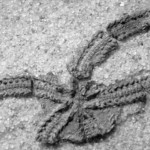In late July, my husband and I found a bunch of crawdads, including a 3-4 inch monster that is easily the biggest crawdad I've ever seen near the mountains, resting in a small pool along the Roaring River in North Carolina. My toes have been at the receiving end of one too many pinches and I found this thing terrifying, but even though I refused to touch it, we managed to catch it a bucket. Fortunately, my Ohio-raised grandfather fearlessly displayed it for a few photographs before we returned the creature to its kingdom. There were several other crawdads much smaller and, based on coloration, of different species than the big guy.
The NC Wildlife Resources Commission has an excellent listing of the numerous species found in the state, including photographs, detailed descriptions, illustrations, and range information. I'm no crawdad expert and there are over 40 species in NC, but I'm guessing that our fellow was an Appalachian Brook Crayfish (Cambarus bartonii), one of the most common and widespread species here.
It turns out that southeastern America has the greatest diversity of crayfish, with over 300 species. New species of crawdad are found in NC almost every year, such as this one described in 2006. Species are distinguished based on a variety of factors, including color, size, markings, and unique anatomical features that anybody but a trained specialist might overlook.
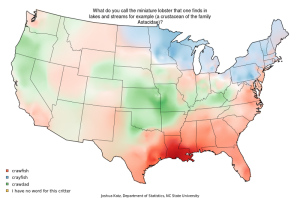 America might also have the greatest diversity of different words for a crayfish (crayfish, crawfish, crawdads)! I call them crawdads, having learned the term as a youngster from the other kids in my rural western NC neighborhood. I was never brave enough to follow their lead, however, in sampling the crawdads: their preferred method was roasting the crawdads over a campfire. In the map to the right, red equals crawfish, green equals crawdad, and blue equals crayfish. If you're wondering, the "proper" word, as used in scientific publications, is crayfish.
America might also have the greatest diversity of different words for a crayfish (crayfish, crawfish, crawdads)! I call them crawdads, having learned the term as a youngster from the other kids in my rural western NC neighborhood. I was never brave enough to follow their lead, however, in sampling the crawdads: their preferred method was roasting the crawdads over a campfire. In the map to the right, red equals crawfish, green equals crawdad, and blue equals crayfish. If you're wondering, the "proper" word, as used in scientific publications, is crayfish.
Crayfish Taxonomic Characteristics
Along with shrimp, lobsters, and crabs, crayfish are arthropods of the order Decapoda. Below is a list of distinguishing features of the taxonomic groups that crayfish fall under. The defining feature of decapods are their maxillipeds, or mouth appendanges, which you've probably seen at work busily sweeping across the decapod's mouth.
Arthropoda
- Metamorism (segmented)
- Exoskeleton of hardened chitin
- Each segment has 1 pair of appendages
- Jointed appendages
Mandibulata
- First appendages modified to antennae on head
- Mandibles on third segment
Crustacea
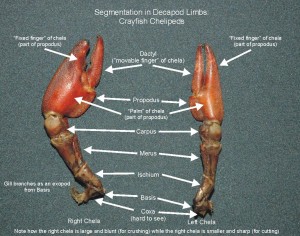 Head has 5 pairs of appendages
Head has 5 pairs of appendages- 1st antennae
- 2nd antennae
- 3 mouth parts
- Mandible
- 1st maxilla
- 2nd maxilla
- Typical appendage (biramous)
- Protopod
- Coxa
- Basis
- Exopod (away from body)
- Endopod (5 segments)
- Ischim
- Merus
- Carpus
- Propodus
- Dactyl - becomes claw
Malacostraca
- 14 segmented truck
- 8 thorax segments (sometimes under carapace)
- 6 abdomen segments
- 1st antennae biramous
- 1st appendage turned forward for feeding
- Pleopods on abdomen used to swim, burrow
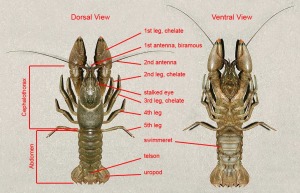
Image credit: OSU
Decapoda
- Maxilliped: first 3 pairs of thoracic appendages fused with head, modified into mouth parts
- 6 pairs of appendages for mouth (1 mandible, 2 maxilla, 3 maxilliped)
- Remaining 5 pairs of appendages are walking legs
This chart compares features of shrimps, lobsters, and crabs, and shows how their different lifestyles have led to different body plans. Since most shrimp are active swimmers, they have light, streamlined bodies. Compare this to the heavily armored lobsters and crayfish, which mainly live in burrows.
| Shrimp | Lobster/Crayfish | Crab | |
| Cross-Sectional Shape | cylindrical | flattened | very flattened |
| Legs | thin | heavy | heavy |
| Exoskeleton | thin | heavy | heavy |
| Uropods ("tail feathers") | yes | yes | no |
| Pleopods | fringed for swimming | digging, ventillating | egg-holding |
| Abdomen | extended | extended | reduced |
| Lifestyle | swimming | burrowing | active benthic |
| Larval Stages | nauplius | zoea, megalops | |
| Other | keel rostrum | 2 claws | wider than long |

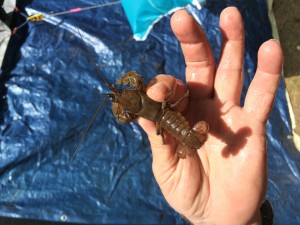
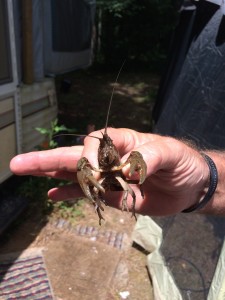
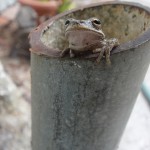
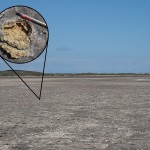

![12 great intro to optical mineralogy resources [updated]](https://www.luckysci.com/wp-content/uploads/2014/01/ol2x-earthbyte-150x150.gif)

